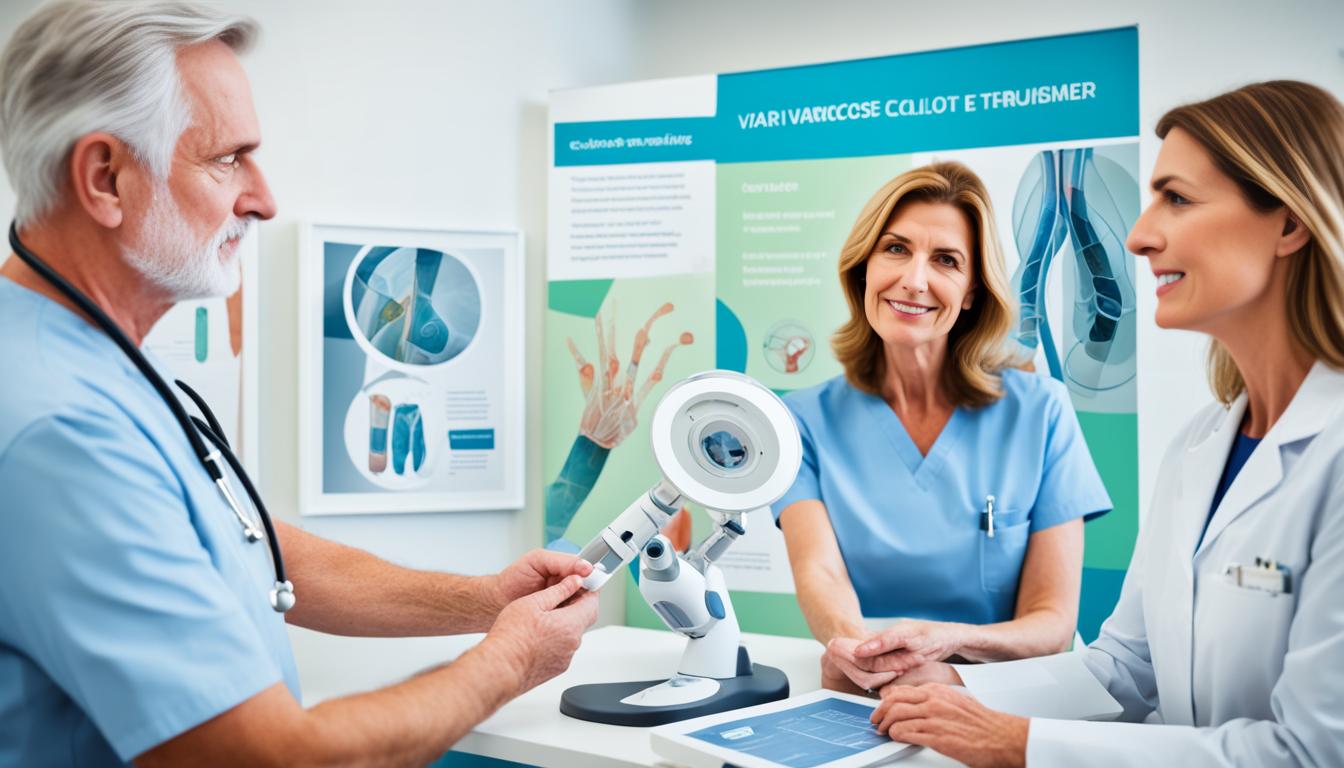Varicose veins are swollen, purple veins you can see under your skin, mostly in the legs. You might notice blue or purple veins that look like snakes near your skin. You could also feel leg pain or a tingling sensation, and your ankles might swell. The main reason for varicose veins is when the blood vessels near the skin are damaged or when the veins don’t have working valves. Getting older, having family members with varicose veins, being pregnant, obese, or standing a lot increases your chances of getting them.
If you notice any symptoms, it’s important to see a specialized vein clinic. Vein experts can figure out what’s wrong and suggest how to treat it.
Sometimes, stem cell therapy is an option for treating varicose veins. This approach helps the body repair the damaged veins, which can improve blood flow and lessen the veins’ appearance.
Key Takeaways:
- Varicose veins are swollen, purple veins primarily seen in the legs.
- Common symptoms include the appearance of blue or purple snakelike veins, aching or tingling legs, and swollen ankles.
- The primary cause is damage to the blood vessels or absence of normal valves in the veins.
- Risk factors include advanced age, family history, pregnancy, obesity, and prolonged standing.
- Seek evaluation and treatment from a reputable vein clinic specializing in varicose veins.
- Stem cell therapy may be an advanced treatment option for varicose veins.
Causes and Treatment of Varicose Veins
Varicose veins are swollen and twisted veins, often seen in the legs. They happen because the valves in the veins become weak or don’t work well. This leads to blood not flowing as it should. Varicose veins might occur due to blood clots, not moving enough, being overweight, or changes in hormones from pregnancy.
To help with varicose veins, some simple steps can be taken. These include not standing or sitting for too long, doing regular physical activities, and keeping an eye on your weight. Sclerotherapy is a method where a doctor injects a liquid into the affected veins. This makes them shrink and close off. It’s fast to recover from and doesn’t involve a big surgery.
If the varicose veins are very bad, someone might need surgery. This can be doing things like tying off or pulling out the veins. Some cases may require this more intensive approach.
If someone is having problems with varicose veins, they should see a doctor who specializes in this. The goal is to find the best way to deal with the veins. By treating the cause and choosing the right treatment, people can feel better and live their lives more fully.
Advanced Diagnosis and Stem Cell Therapy for Varicose Veins
Varicose veins can now be diagnosed more accurately thanks to advanced tools. Doppler ultrasound checks blood flow within the veins. There’s also venography, where a dye helps create clearer images. These methods help experts plan the right treatment for each person.
Stem cell therapy is a new, less-invasive way to treat varicose veins. It boosts blood flow and reduces spider veins without surgery. Stem cells help heal damaged veins, improving overall vein health. In Thailand, this treatment has become a top choice for many patients.
In Thailand, top benefits include access to experts in vein care and stem cell therapy. By using stem cells, these clinics offer a safe choice. This treatment doesn’t just hide spider veins; it fixes the vein problems, giving lasting, natural results.
FAQ
Q: What are varicose veins?
A: Varicose veins are swollen, often purple, veins in the legs. They bulge out under the skin.
Q: What are the symptoms of varicose veins?
A: You might see blue or purple lines on your skin. Your legs can ache or feel tingly. Also, you might notice swollen ankles.
Q: What causes varicose veins?
A: Damage to blood vessels near the skin or weak valves in veins can cause them. Not moving enough, being too heavy, or pregnancy’s hormonal changes also play a part.
Q: How can varicose veins be prevented?
A: Avoid standing or sitting for too long. Keep moving with exercise and stay at a healthy weight. Compression stockings can also help.
Q: When should I seek treatment for varicose veins?
A: Serious symptoms or if the veins worry you, you should see a vein specialist. They can offer evaluation and treatment options.
Q: What are the treatment options for varicose veins?
A: Conservative options like lifestyle changes and compression stockings are first. For more severe cases, treatments like sclerotherapy or surgery might be needed.
Q: What is sclerotherapy?
A: In sclerotherapy, a special solution is injected into the vein. This makes the vein shrink and close off.
Q: Can varicose veins be treated with surgery?
A: Yes. Surgeons may tie off or take out the bad veins in procedures called ligation or stripping.
Q: How are varicose veins diagnosed?
A: Doctors use tools like Doppler ultrasound and venography to check the veins. These tools help them see the problem clearly.
Q: What is stem cell therapy for varicose veins?
A: Stem cell therapy uses cells to repair the damaged veins. This can improve blood flow and make varicose veins look better.
Q: Can stem cell therapy be used for varicose veins treatment?
A: Yes, more doctors are offering stem cell therapy as a treatment. It’s seen as a less invasive option. Reputable vein clinics are starting to use it.

